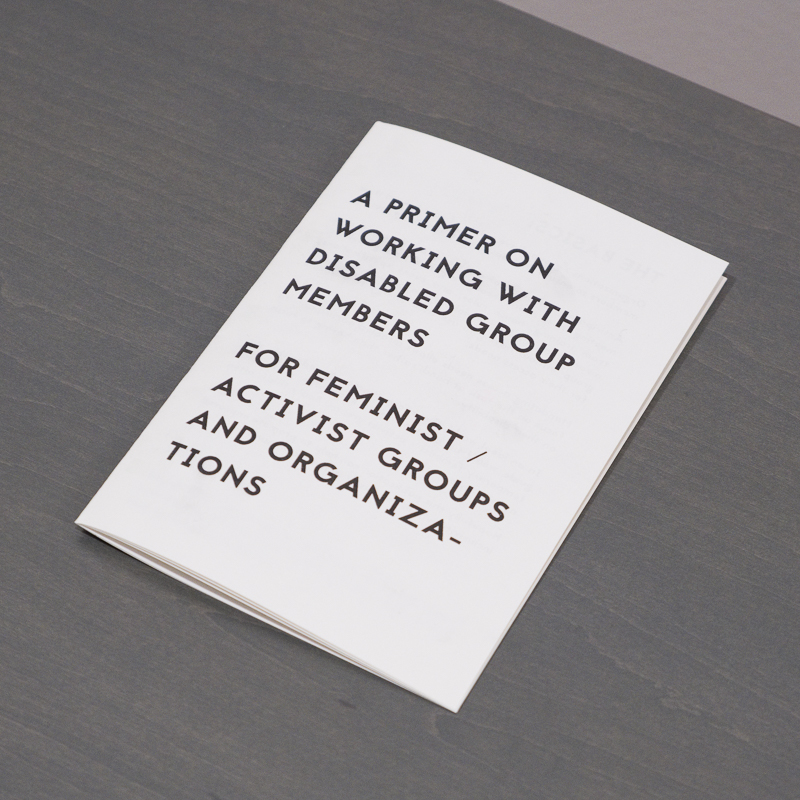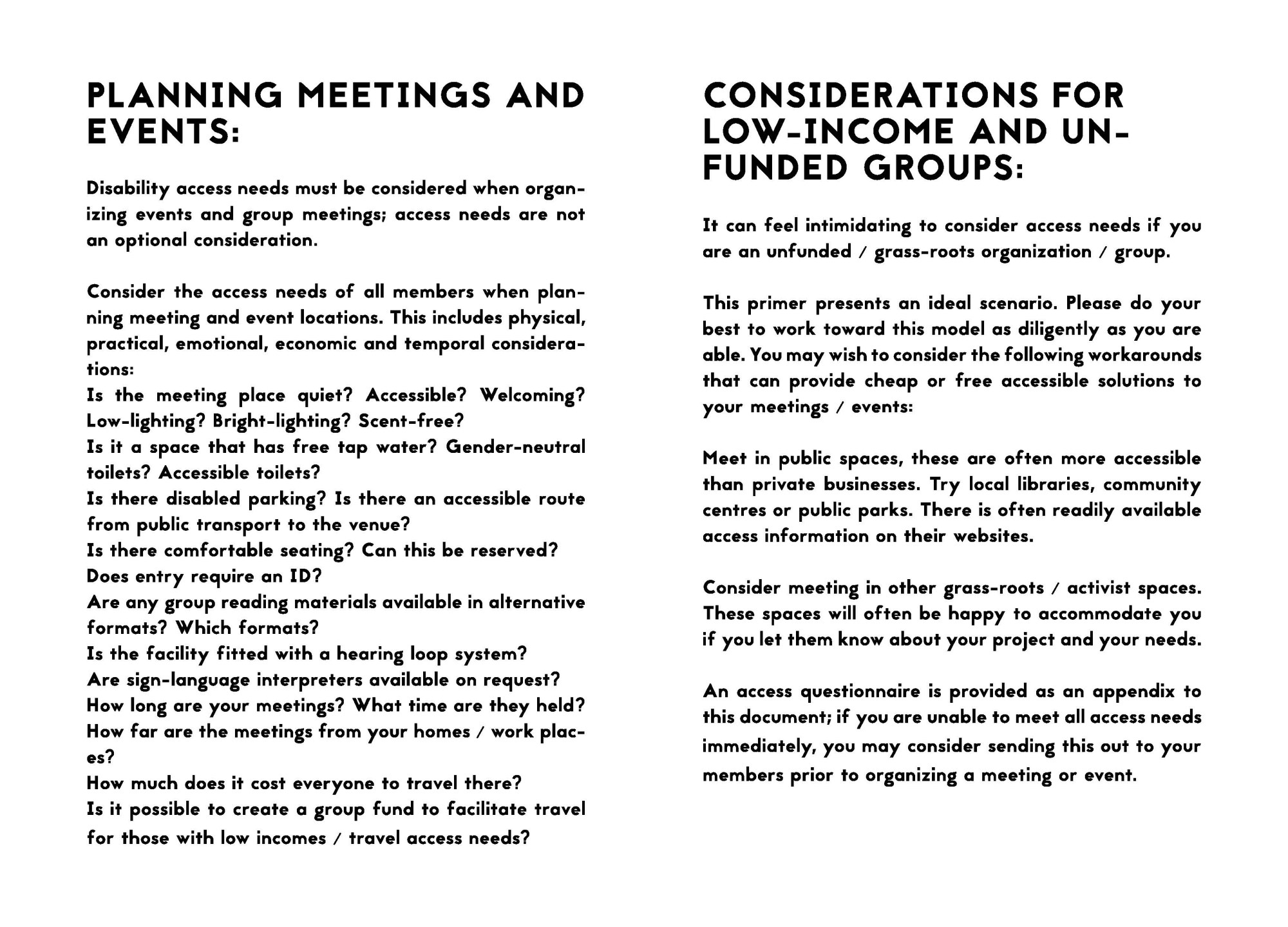Even in an age of inclusivity, matters regarding disability are still routinely overlooked. Transdisciplinary artist Romily Alice Walden wants this to change. Featuring in two NYC gallery shows, the British artist’s new work seeks to address the deafening silence that surrounds ableism.
Sparked by her own experience, Walden was surprised to find that even in progressive organizations, access requirements were rarely considered. “I found when I was working with activist groups that a lot of them were completely unprepared for working with a disabled member,” she recounts. “By the fourth time it happened I was like: “Oh, this isn’t an individual problem, this is a systemic problem.””
Thus Walden’s primer was born, 12 riso-printed pages of practical instructions for feminist activist groups and organizations on how to make their work more accessible, currently on show at the 13th A.I.R. Biennial. “One of the main goals with this text is to stop this work having to be done repeatedly on an individual level. There are disabled people who are having to advocate for their needs over and over again in every new situation that they enter; this becomes really exhausting and demoralizing.”
This isn’t the first time Walden has confronted the body in her work — her previous series Utopias (IRL//URL) looked at the visibility of gendered and sexualized bodies in the online space. It is, however, the first time she’s addressed the theme of disability. “Initially I was hesitant to make work that directly spoke to my experience of disability because it felt so personal. But the more time I spent researching academic and political understandings of sickness and disability, the easier I found it to manage my condition.”

To most, Walden will be better known for her captivating neon installations, one of which will soon be on display at SOHO20 gallery. Featuring seven neon tubes, each will represent a facet of “wellness”, from emotional, to occupational, to sexual. “Every hour I will assign each wellness category a number from zero to ten, and that will determine each tube’s brightness for the next hour,” Walden explains. “What you’ll get is an installation that is constantly shifting to create a durational performance of sickness. For the first week of the show the work will display my data, and for each week following, a different disabled individual will take over the installation.”
Why did it feel like the right time to begin exploring this topic?
I think being sick and living in a body that doesn’t comply with normative expectations of what bodies are supposed to do has a huge effect on the way I move through the world. It became such a dominant part of my life that it was impossible for it not to come out within my work.
Culturally we’re not taught to view sickness and disability as political. We’re taught to view them as personal, as individual responsibilities. It’s seen as embarrassing to talk about health in the same way it’s seen as embarrassing to talk about money.
It’s strange that we live in a culture of wellness, and yet disability is still something we struggle to fully accommodate. Is this something you’re thinking about in your work?
Definitely. That kind of disconnect is exactly what led me to creating the primer. We don’t discuss disability in public. People are afraid to talk about it. The more that we can bring an awareness into mainstream public discourse, the easier it will be to be for people to understand that disability issues aren’t niche issues.
I think the notion of wellness is also really interesting, because it’s been co-opted into this billion dollar industry. A lot of these wellness products and practices are often very expensive and totally prohibitive to access for people living with chronic illness. Wellness culture emphasizes this idea that health is predicated on individual responsibility; that in some way if you’re sick, it’s because you’re not working hard enough at self-care. That’s a really dangerous attitude, because it only further isolates people who can’t access those things, or who have medical conditions that aren’t going to be alleviated by drinking the right smoothie.

Disability is often viewed in a very binary way in society; either you’re disabled or you’re not. In what way does this thinking limit our understanding?
By positioning disability and ability as binary, you perpetuate this fantasy that bodies are static and fixed, as if they’re not constantly in motion; changing, developing, getting sick, aging etc. In that evolution there is a constant vulnerability and fragility. I also think it’s worth troubling the concept of disability itself, because disability is relative. A condition that’s disabling in a place where you have to walk for miles to access basic provisions isn’t as disabling in a city where you have everything you need within easy reach. Once you begin to unpick the idea that disability is this fixed state that lives in the body, and start to see it as relative to both the society and the culture in which an individual resides, then you can start to let go of this idea of disabled and able bodied as permanent or concrete categories.
How else can we look to educate ourselves, particularly regarding disability?
If you want to hear more disabled perspectives I’d recommend following Mia Mingus, Star Seeded, hot.crip, Annie Segarra, and Ruby Allegra on Instagram. I also love the work of artists/writers Johanna Hedva, Laura G. Jones, Feminist Healthcare Research Group, Leah Clements, Sophie Hoyle, Lizzy Rose, Clay A.D, Amy Rosa McLachlan, Ezra Benus, Alison Kafer, and Shawanda Corbett.
Romily’s primer will be showing at A.I.R. gallery until 3rd February, and her installation ‘My Body Is The House That I Live In’ will be on show at SOHO20 8th February to 8th March.

